
Salty Sam’s Fun Blog for Children
Post Number 62
ldioms
Hello Everyone
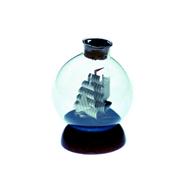
As you know l live in a seaside community; boats and fishermen pass by my lighthouse all the time.
That is why l was so interested to hear about what my nephews learnt about in their English class with Miss Pringle this week.
A lot of phrases we use in English come from something that happened in history. A lot of them came from life on boats.
Here are some of the idioms and their origins. l thought you would find it interesting to learn about them. ![]()
Ship-shape and Bristol fashion
This means to be smart and tidy and in good order.
When a ship went into the Port of Bristol the inspectors had a reputation for being very strict in their expectations about health and safety rules being obeyed.
Feeling under the weather
This means feeling ill.
When sailors felt unwell and went to lie down, they went to the bottom of the ship. This was the warmest place; it was away from the wind and the rain. lt is also the place that tilts the least. When you feel ill, being thrown around in your bed doesn’t help!
Swinging the lead
This means not working very hard when you should be.
ln the olden days, when a ship went near land in uncharted (unmapped or unknown) waters the people on board needed to know how deep the water was.
A sailor would stand on the ship and let a rope out down into the water. The rope would have knots spaced evenly along it and a lead weight at the bottom.
When the weight hit the bottom of the ocean (or river) the sailor would pull up the rope and count the number of knots that had been in the water. ln this way he could constantly check to see if there was enough water between the ship’s bottom and the seabed.
lf the water became too shallow, there was a risk of the ship running aground and getting stuck or being holed.
lt was considered a very easy job compared to most that a sailor had to do.
To rock the boat
lt means to turn a happy situation into an unstable one.
lf you are in a boat with other people and you move about and start rocking the boat, it could make things more dangerous for those other people as there is a risk of the boat tipping over.
To take the wind out of someone’s sails
lt means to make someone feel silly and defeated.
A ship can take the wind out of another’s sails if it passes close to it on the windward side (the side of the ship the wind is coming from). This is because it blocks the wind and without the wind a ship will stop moving.
To spoil the ship for a ha’porth of tar
This means to spoil something valuable or jeopardise (risk ruining) a whole project because of trying to save a little bit of money or failing to do something very small.
This comes from when ships were coated with tar to make them water-proof. lf you left a patch of hull bare, it would be unprotected. The whole ship could sink from water seeping through the smallest of holes left in the tar.
Something is plain sailing
Life is progressing well without problems and complications.
High-fluting and riff-raff
And now a contribution from America; the high-fluting were the rich people who sailed along rivers in paddle steamers with high funnels, and the riff-raff were the not-so-rich people who had to travel on rafts and other less comfortable craft.
When my ship comes in
This means – when l become rich.
This comes from when people waited for cargo to come into port. When the ship arrived, the cargo could be sold, earning the owner a lot of money.
People use idioms every day when they speak and it is interesting to know how they started, isn’t it?
lf you want to visit some really old ships, there are plenty around the country.
There is Nelson’s Ship, The Victory, at Portsmouth, the Frigate Unicorn at Dundee, the Golden Hind in Brixham and London and there is lots to see at Chatham Dockyard in Kent too.
Bye bye everyone – don’t forget to subscribe to my blog!
Love and kisses
Salty Sam

www.christina-sinclair.com


Bill and Bob’s Joke of the Week![]()
![]()
Bob: What do you call a baby whale that is crying?
Bill: l don’t know. What do you call a baby whale that is crying?
Bob: A little blubber!

Salty Sam © Christina Sinclair 2015
Unauthorized use and/or duplication of material from this blog without express and written permission from this blog’s author and owner is strictly prohibited.
Links may be used to www.christina-sinclair.com

Picture Gallery
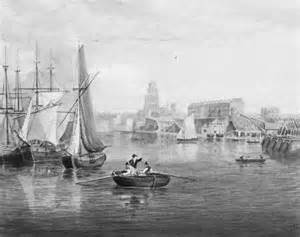
The historic port of Bristol
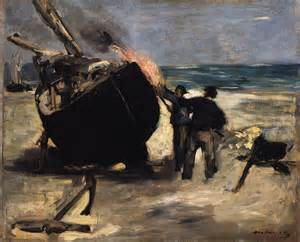
Tarring a boat to make it waterproof
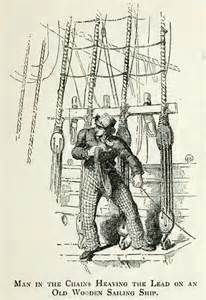
Swinging the lead
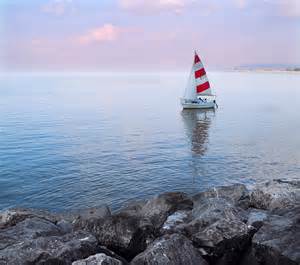
Plain sailing

The funnels of a paddle steamer

The Victory

The Unicorn
Chatham Dockyard


 THE SALTY SAM NEWS DESK
THE SALTY SAM NEWS DESK

Like a lot of people, Bill and Bob get confused about how to use apostrophes.
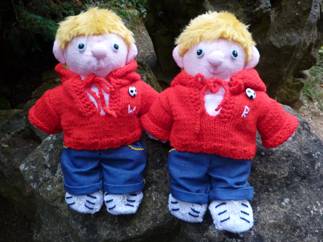
This is how Miss Pringle explained it to them in their English class this week…
(Lots of notices and signs you see around have apostrophes missing – this doesn’t help children to learn them. Probably the adults who made the notices didn’t know how to use them properly either!)

HOW TO USE APOSTROPHES
What is the difference between it’s and its?
APOSTROPHES OF OMISSION
Answer=
it’s means it is
(Apostrophe of omission [omission means left out] – the apostrophe stands in place of the ‘i’ in ‘is’.)

Example = It is cold today.
It’s cold today.
BUT
its belongs to the family

its
his
her
my
your
their
our
None of these words have apostrophes.
Example = The dog is playing with its ball.
The dog is playing with his ball.
The dog is playing with her ball.
The dog is playing with my ball.
APOSTROPHES OF POSSESSION
1ST RULE
The boy’s book one boy who owns one book
The boy’s books one boy who owns more than one book
The boys’ book more than one boy who own one book
(they share the book)
The boys’ books more than one boy who own more than one book
2ND RULE
The children’s book more than one child – one book
The children’s books more than one child – more than one book
Note that the apostrophe goes before the ‘s’ because the word ‘children’ is already plural – you don’t need to show the word ‘children’ is a plural with punctuation.
So – you always put the apostrophe before the ‘s’ unless you have to put it after the ‘s’ to indicate a plural.
The policemen’s uniforms
The women’s hats
3RD RULE
If a singular noun ends in ‘s’
The princess’s dress (one princess and one dress)
If a plural noun end in ‘s’
The princesses’ dresses (more than one princess and more than one dress)
If a proper noun ends in ‘s’
King James’ reign
or
King James’s reign
TIP
If you find all of this difficult, learn one rule at a time – just keep reading the explanation until it clicks into your head. You will get better marks for your English examinations if you get your punctuation right.


At the beginning of this term Miss Pringle said that she really didn’t want the classroom to get in the same mess as it did last term.
She had an idea which she thought might help prevent the muddle and mess she had had to endure.
She procured (obtained) a box for each child, and put them all on some new shelves that Mr Grump the caretaker had constructed at the back of the classroom.
The boxes were for the children to put their gloves, scarves, hats and snacks into.
In the first art lesson of the term, the children had to label their own box.
They wrote their names on a piece of card and stuck gummed paper shapes onto the label as well.
The shapes could make up any picture they liked – but it had to be made neatly!
Oh yes – and they had better not forget their possessive apostrophes either!
Bill’s box had a boat on it and Bob’s box had an anchor on it.
The labels were then sticky-taped to the front of the boxes.
You might like to make a label for any storage baskets you have in your bedroom; on your shelves or in your cupboard.
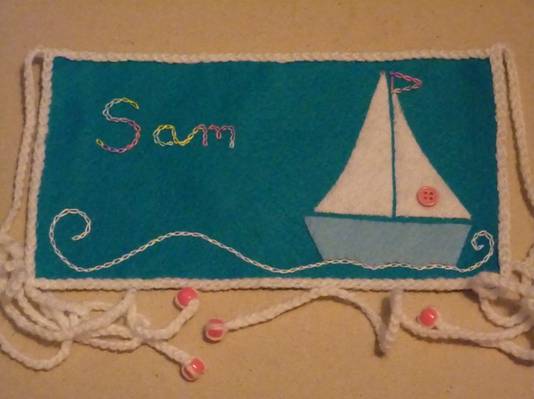
Of course this idea would work in fabric as well. This name label can be tied to the front of a storage basket. The crocheted trim looks like rope to match in well with the boat theme.
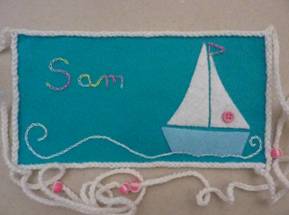
The label doesn’t have to have a name on it; it could have a word describing what is stored in the basket.
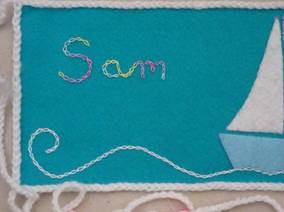
NEWSDESK MINIMAKE
A STORAGE BASKET PLAQUE
- First, cut a piece of felt the size you want your label to be – measure against the end or side of your basket.
- The label in the photograph is 22½cm/9 inches by 12cm/4¾ inches.
- Decorate the front with pieces of felt cut into shapes and sewn into place – practise with paper before you cut out any felt.

1. Embroider a name onto the front using chain stitch or running stitch.
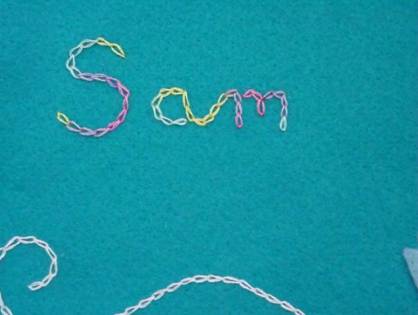
2. When you are happy with your design crochet 4 chains to edge the top and sides and sew them on with sewing thread – the ropes for the top and bottom are 46 chains and the side ropes are 200 chains giving plenty of length to tie the plaque to the basket.
3. Tie a bead onto the end of each tie to finish them off neatly.



And finally…
Spring comes to Rocky Bay!

Green tree flowers

*********************
TO ADVERTISE ON THIS BLOG
PLEASE CONTACT:
christina.sinclair.ads@aol.co.uk
*********************


Quick Quiz
Can you put these into order of size?
- galleon
- oil tanker
- canoe
- cruise ship
- dinghy
- sea ferry
- river ferry


BLOW MY FOGHORN!!!

PLUS
Salty Sam fans can join in with their comments and share them with children all over the world. You must ask permission if you are not an adult.
Enter your e-mail address to subscribe to my blog and receive new Salty Sam Blog Posts for free by e-mail every week. Your address will be kept private and will not be shared with any third party.
Sign me up at the side bar




lt’s the Weekend!

HOW TO MAKE A PAPER BOAT
Have you ever played Poohsticks?
You throw sticks off a bridge one side and rush to the other side; which is downstream of course, to see whose stick comes out first.
Bill, Bob and Henry have invented their own game called Rocky Bay Boats.

They go to the little bridge by Auntie Alice’s cottage and throw paper boats into the river. They make them out of coloured paper so that they know whose is whose.
- Take a rectangle of paper. Put it in front of you on the table in an upright position.
- Fold the upper edge down to the lower edge.
- Fold the two upper corners down to the centre about two thirds of the way down. Now you have a triangular top.
- Fold the single layers at the bottom up and outwards each side.
- Draw boat features onto your paper if your want to.
- Put your fingers inside and pull the boat into a three dimensional shape.
- If you want to make boats to have a race with your friends, don’t forget to make them different colours so that you can keep track of them – and if one of them gets stuck at the side of the stream don’t go after it – you might fall in!
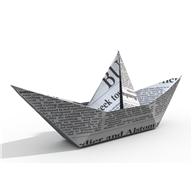
Please note that the material on this blog is for personal use and for use in classrooms only.
It is a copyright infringement and, therefore, illegal under international law to sell items made with these patterns.
Use of the toys and projects is at your own risk.
©Christina Sinclair Designs 2015



Quick Quiz Answers
From smallest to biggest:-
- canoe
- dinghy
- river ferry
- galleon
- sea ferry
- cruise ship
- oil tanker

A sea ferry



Such a useful Post!
l am glad you think so. Thanks.